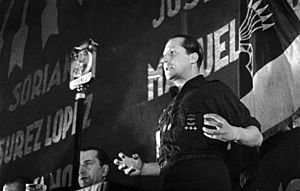José Antonio Primo de Rivera facts for kids
Quick facts for kids
José Antonio Primo de Rivera
|
|
|---|---|
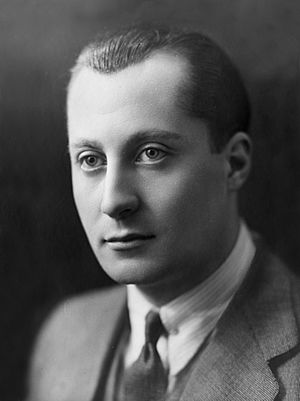 |
|
| Member of the Cortes | |
| In office 30 November 1933 – 7 January 1936 |
|
| Constituency | Cádiz |
| Personal details | |
| Born |
José Antonio Primo de Rivera y Sáenz de Heredia
24 April 1903 Madrid, Spain |
| Died | 20 November 1936 (aged 33) Alicante, Spain |
| Cause of death | Execution by firing squad |
| Resting place |
|
| Political party |
|
| Parent |
|
| Relatives |
|
| Alma mater | University of Madrid |
| Occupation |
|
| Military service | |
| Branch/service | Volunteer |
| Years of service | 1923–1924 |
| Rank | Reserve second lieutenant |
| Unit | Húsares de la Princesa |
José Antonio Primo de Rivera (born April 24, 1903 – died November 20, 1936) was a Spanish politician. He is known for starting a political group called the Falange Española ("Spanish Phalanx").
He was the oldest son of General Miguel Primo de Rivera. His father was the leader of Spain from 1923 to 1930. José Antonio first worked as a lawyer. He then entered politics to protect his father's good name.
In October 1933, he started the Falange Española. Soon after, he ran in the 1933 election. He won a seat in the Spanish Parliament.
In 1936, he supported a military uprising against the government. This led to the Spanish Civil War. He was put in jail before the war began. He was accused of working against the government. He was sentenced to death and executed early in the war.
After his death, many people who supported the Nationalist side saw him as a hero. After Francoist Spain was established, he was called a "martyr." His image was used in propaganda. Many churches in Spain had the words "José Antonio ¡Presente!" written on them.
Contents
Biography
Early Life and Education
José Antonio Primo de Rivera was born in Madrid on April 24, 1903. His father was Miguel Primo de Rivera, who later became Spain's leader. His mother, Casilda Sáenz de Heredia, died when he was five. His aunt raised him after that.
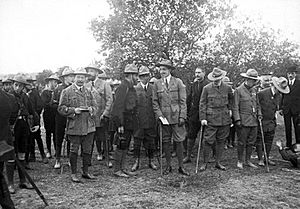
He was taught at home and learned English and French. He studied law at the Complutense University of Madrid from 1917 to 1923. He helped create a student group that disagreed with his father's education policies. He earned both his Bachelor's and Doctor's degrees in 1923.
After university, he joined the military for one year. He served in a cavalry regiment in Barcelona. He became a lawyer in 1925 and opened his own office.
José Antonio decided to enter politics after his father died in 1930. He wanted to defend his father's memory. In 1931, he became the "Perpetual Dean of the Illustrious College of Lawyers of Madrid." He was briefly held in 1932 for being involved in an attempted uprising.
Becoming a Falangist Leader
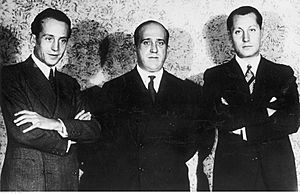
On October 29, 1933, Primo de Rivera started the Falange Española. This was a nationalist political group. It was inspired by some ideas from the Fascist movement in Italy. These ideas included the need for strong leadership and a structured society. The first meeting was held in Madrid. He spoke about his concerns with liberal democracy.
He believed that using force was acceptable for a just cause. However, he was at first hesitant to use violence. After a party member named Juan Cuéllar died, he became more willing to accept it. This led to more violence from both sides.
He was elected to Parliament in November 1933. He represented the region of Cádiz.
In February 1934, the Falange merged with another group. They formed the Falange Española de las JONS. José Antonio became its leader. He believed that violence was right against a government he saw as influenced by communists.
José Antonio, who came from an upper-class family, started wearing the Falange's blue shirt uniform. This uniform was adopted in October 1935. It was a clear reference to Italian Fascism.
In 1935, he helped write the words for the Falangist song, "Cara al Sol" (Face to the Sun). Every member of the Falange had to obey without question.
In the election of February 1936, the Falange won very few votes. However, after a left-wing group won, Spain became unstable. Many new members joined the Falange. By July, the party had grown to over 40,000 members.
Imprisonment and Death
On March 14, 1936, José Antonio was arrested in Madrid. He was charged with illegally owning weapons. Nine weeks later, he was moved to a prison in Alicante.
From prison, he secretly kept in touch with Falange leaders. He also contacted General Emilio Mola several times. On October 3, he was accused of working against the government. These were serious charges, even though he was in prison before the uprising began.
Primo de Rivera defended himself in court. On November 18, he was found guilty and sentenced to death. The judges and the public tribunal asked for his sentence to be changed to life in prison. However, most government ministers rejected this. He was executed by firing squad on November 20 in Alicante.
Some people say that the government offered to exchange him for another prisoner. They say Francisco Franco refused the offer. Others say the government rejected the deal. Either way, his death removed a potential rival for Franco. It was known that the two men did not like each other.
What Happened After His Death
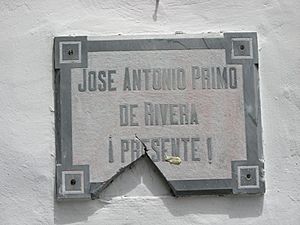
The Falange joined the military uprising against the government. The party grew in importance during the war. However, it lost its independence. In 1937, General Franco took full control. He merged the Falange with another group. He became the leader of this new party.
Franco's rule created a special honor for José Antonio. Falangists called him "El Ausente" (The Missing One). This name was used because his death was kept secret for a while. Many Falangists hoped he would return. He was seen as a hero who died for his cause.
After the war, two symbols of his importance were common. First, a stone slab on many churches listed local Nationalists killed in the war. Primo de Rivera's name was always at the top. Second, the rallying cry "José Antonio—¡Presente!" was used. This meant he was still with them in spirit.
When Spain became a democracy, the focus on Primo de Rivera lessened. In 1981, a major street in Madrid was renamed. Franco had named it "Avenida José Antonio Primo de Rivera." In 2005, a memorial to him was removed in Guadalajara.
Where He Was Buried
After the war ended in 1939, Primo de Rivera's body was carried from Alicante to Madrid. This was a 300-kilometer journey. He was first buried at El Escorial, a royal site.
Reburial at the Valley of the Fallen
In 1959, Primo de Rivera's body was moved. He was reburied in the basilica of the Valley of the Fallen. This site is in the Guadarrama mountains. Between 1975 and 2019, Francisco Franco was also buried nearby.
In 2022, Primo de Rivera's family asked for his body to be moved again. They said he wanted a Roman Catholic burial. A new law aimed to make the Valley of the Fallen a civil cemetery.
Reburial at San Isidro Cemetery, Madrid
In April 2023, Primo de Rivera's family moved his remains from the Valley of the Fallen. He was reburied in Saint Isidore Cemetery in Madrid.
His Ideas
José Antonio believed in strong leadership in politics. He was influenced by Italian Fascism. He believed in "corporatism," which means organizing society by groups like workers and employers.
He famously spoke about using "fists and guns" if needed. He said that to improve Spain, "if this has to be achieved through violence, we shall not be stopped by violence." He wanted to offer a different way of governing than liberal democracy.
He also believed in the idea of Spain as a "unity of destiny." This meant all the different peoples of Spain working together for a common future.
Genealogy
| Ancestors of José Antonio Primo de Rivera y Sáenz de Heredia | |||||||||||||||||||||||||||||||||||||||||||||||||||||||||||||||||||||||||||||||||||||||||||||||||||||||||||||||||||||||||||||||||||||||||||||||||||||||||||||||||||||||||||||||||||||||||||||||||||||||||||||||||||||||||||||||||||||||||||||||||||||||||||||||||||||||||||||||||||||||||
|---|---|---|---|---|---|---|---|---|---|---|---|---|---|---|---|---|---|---|---|---|---|---|---|---|---|---|---|---|---|---|---|---|---|---|---|---|---|---|---|---|---|---|---|---|---|---|---|---|---|---|---|---|---|---|---|---|---|---|---|---|---|---|---|---|---|---|---|---|---|---|---|---|---|---|---|---|---|---|---|---|---|---|---|---|---|---|---|---|---|---|---|---|---|---|---|---|---|---|---|---|---|---|---|---|---|---|---|---|---|---|---|---|---|---|---|---|---|---|---|---|---|---|---|---|---|---|---|---|---|---|---|---|---|---|---|---|---|---|---|---|---|---|---|---|---|---|---|---|---|---|---|---|---|---|---|---|---|---|---|---|---|---|---|---|---|---|---|---|---|---|---|---|---|---|---|---|---|---|---|---|---|---|---|---|---|---|---|---|---|---|---|---|---|---|---|---|---|---|---|---|---|---|---|---|---|---|---|---|---|---|---|---|---|---|---|---|---|---|---|---|---|---|---|---|---|---|---|---|---|---|---|---|---|---|---|---|---|---|---|---|---|---|---|---|---|---|---|---|---|---|---|---|---|---|---|---|---|---|---|---|---|---|---|---|---|---|---|---|---|---|---|---|---|---|---|---|---|---|---|---|---|
|
|||||||||||||||||||||||||||||||||||||||||||||||||||||||||||||||||||||||||||||||||||||||||||||||||||||||||||||||||||||||||||||||||||||||||||||||||||||||||||||||||||||||||||||||||||||||||||||||||||||||||||||||||||||||||||||||||||||||||||||||||||||||||||||||||||||||||||||||||||||||||
Images for kids
See also
 In Spanish: José Antonio Primo de Rivera para niños
In Spanish: José Antonio Primo de Rivera para niños


